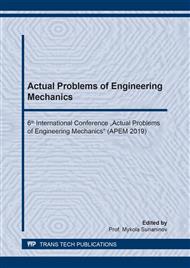[1]
Lightweight aggregate concrete. Recommended extension to Model Code 90, Guide. Identification of research needs, technical report. Case Studies, State-of-art report. fib Bulletin No. 8, 2000. 118 p.
Google Scholar
[2]
Bolshakov, V. I., & Dvorkin, L. I. (2016). Structure and Properties of Building Materials. Switzerland: Trans and Technical Publication Ltd.
Google Scholar
[3]
Dubrov, Yu., Bol'shakov, V., & Volchuk, V. (2015). Paths to Identification of Periodic Multicriteria Technologies. Saarbrucken, Deutschland: Palmarium Academic Publishing. (in Russian).
Google Scholar
[4]
Mandelbrot, B. B. (1982). The Fractal Geometry of Nature. New York–San Francisco: Freeman.
Google Scholar
[5]
Volchuk, V., Klymenko, I., Kroviakov, S., & Orešković, M. (2018). Method of material quality estimation with usage of multifractal formalism. Tehnički glasnik - Technical Journal, 12 (2), 93-97. https://hrcak.srce.hr/202359.
DOI: 10.31803/tg-20180302115027
Google Scholar
[6]
Bolshakov, V.I, & Volchuk, V. N. (2011). Materials Science Aspects of Using of Wavelet-Multifractal Approach to an Evaluation of Structure and Properties of Low-Carbon Low-Alloyed Steels. Metallofizika i Noveishie Tekhnologii, International Scientific and Technical Journal of the Institute of Metal Physics. G.V. Kurdyumov National Academy of Sciences of Ukraine, 33(3), 347-360.
DOI: 10.15407/mfint.43.06.0753
Google Scholar
[7]
Bolshakov, V., Volchuk, V., & Dubrov, Yu. (2016). Fractals and properties of materials. Saarbrucken, Deutschland: Lambert Academic Publishing, 62-66.
Google Scholar
[8]
Mishutn, A., Kroviakov, S., Pishev, O., & Soldo, B. (2017). Modified expanded clay light weight concretes for thin-walled reinforced concrete floating structures. Tehnički glasnik - Technical Journal, 11(3), 121-124.
Google Scholar
[9]
Kroviakov, S. & Mishutn, A. (2017). Increasing the durability of lightweight structural concrete for hydraulic engineering and transport structures by treating the surface of a porous aggregate. Science and construction, 3, 50-58. (in Ukrainian).
Google Scholar
[10]
Volchuk, V. M. (2017). On the Application of Fractal Formalism for Ranging Criteria of Quality of Multiparametric Technologies. Metallofizika i Noveishie Tekhnologii, International Scientific and Technical Journal of the Institute of Metal Physics. G.V. Kurdyumov National Academy of Sciences of Ukraine, 39(7), 949-957. (in Russian) https://doi.org/10.15407/mfint.39.07.0949.
DOI: 10.15407/mfint.39.07.0949
Google Scholar
[11]
Kroviakov, S. & Mishutn, A. (2017). Production technology of modified expanded clay lightweight concrete for floating structures. The Scientific Journal of Cihan University – Sulaimanyia, 1(4), 2-10.
Google Scholar
[12]
Bolshakov, V. I., Volchuk, V. M. & Dubrov, Yu. I. (2018). Regularization of One Conditionally III-Posed Problem of Extractive Metallurgy. Metallofizika i Noveishie Tekhnologii, International Scientific and Technical Journal of the Institute of Metal Physics. G.V. Kurdyumov National Academy of Sciences of Ukraine, 40(9), 1165-1171. https://doi.org/10.15407/mfint.40.09.1165.
DOI: 10.15407/mfint.40.09.1165
Google Scholar
[13]
Kroviakov, S., Mishutin, A., Pishev O. (2018). Management of the Properties of Shipbuilding Expanded Clay Lightweight Concrete. International Journal of Engineering & Technology, [S.l.], 7(3.2), 245-249, http://dx.doi.org/10.14419/ijet.v7i3.2.14412.
DOI: 10.14419/ijet.v7i3.2.14412
Google Scholar


